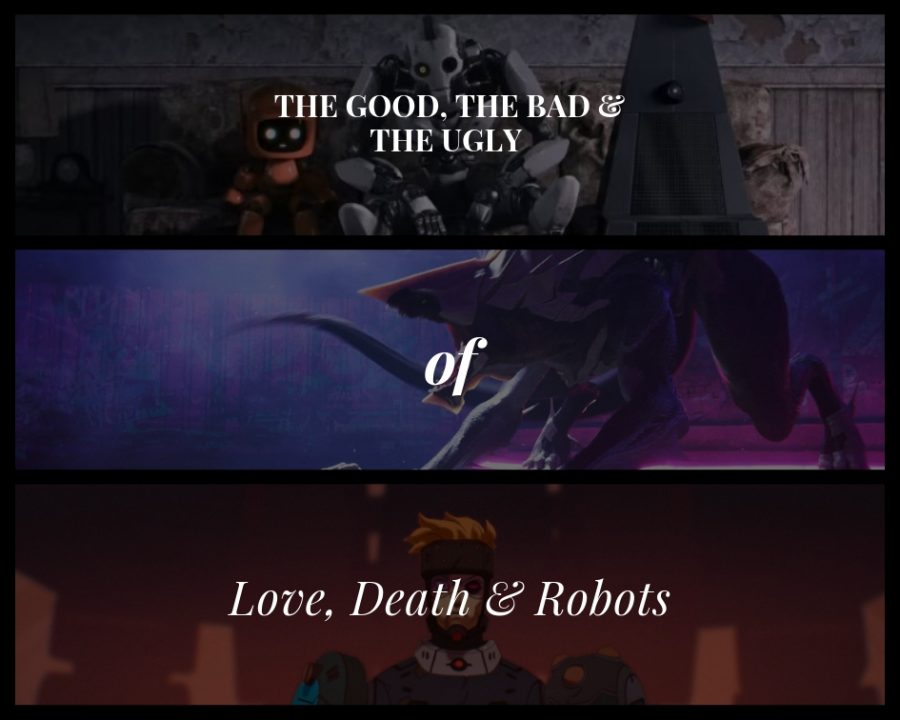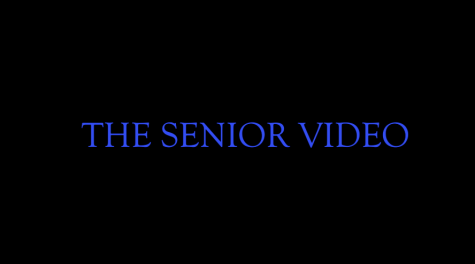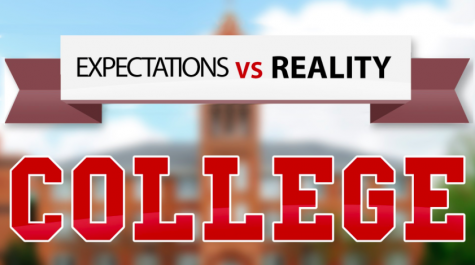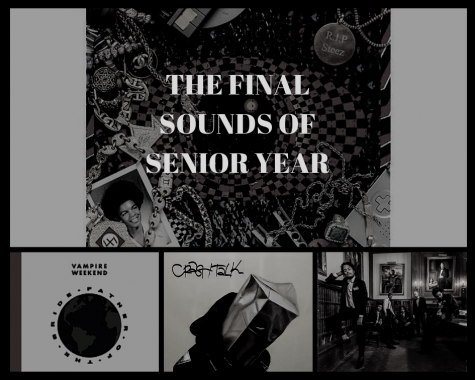Love, Death & Robots: The Good, the Bad, and the Ugly
In the beginning of television history, very few anthology series existed. For those who do not know, an anthology TV show consists of episodes that have very loose connections to the next episode, or none at all. This allows for some very interesting concepts to be explored throughout these series’ run time. Very few shows that utilize this concept have rose to the same prominence as The Twilight Zone. Other shows such as Black Mirror and Room 104 have attempted to recreate the fame The Twilight Zone had obtained decades prior, but have not been able to do so. The most recent attempt at this concept can be seen in the Netflix Original series Love, Death and Robots. As you may be able to tell by its title, all the episodes of the show are centered around love, death, robots, or a mixture of all three. So, how does it hold up to other anthology series?
To start, let’s discuss the positives. The show’s anthology concept gives a breath of fresh air to each episode. The watcher never fully knows what to expect with each new episode. One episode might center on a beast fighting ring, and the next might center around werewolves in the military (Yeah, it can get that weird sometimes). Because the only constant is that the episodes are centered around love, death or robots, the show is able to present a vast multitude of concepts that range from wildly outlandish, to downright depressing or dramatic. However, the best episodes often are a fine balance of both, dramatics and the whimsical. To demonstrate this, we’d like to present you with two episodes that exemplify this idea greatly. The first of these is “Good Hunting.” The episode presents a brilliant dichotomy between the folklore of China, and the British’s imperial conquest of China. The plot of the episode centers around a huli jing, a spirit that is able to change from a human form into that of a fox, and a man who attempts to help her. As the British take over China, the magic of the land is deteriorating gradually, until it is replaced with the science of technology. 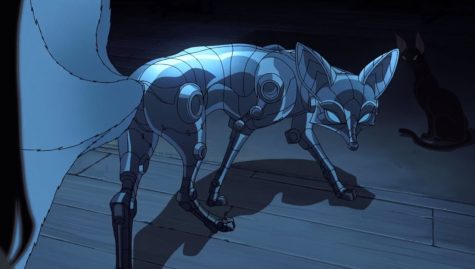 Both of the focal characters lives are forever changed, and it truly serves as a tremendous episode with an incredibly thought out concept, and presents the dark history that surrounds the time period. Another solid episode is “When the Yogurt Took Over.” As you might assume, the episode quite literally centers around a sentient, and almost omniscient, bowl of yogurt. The episode presents the United States government to being inferior to that of a nation ruled by some yogurt. When the Yogurt presents a formula for paying off the national debt, the government fails and leads to even greater ruin. This forces the President of the United States to resign, and declare the Yogurt as the ruler of the nation. We couldn’t make this up if we tried. Overall, the episode is a humorous satire of American politics, and both episodes are brilliantly done and interesting pieces of media to think about.
Both of the focal characters lives are forever changed, and it truly serves as a tremendous episode with an incredibly thought out concept, and presents the dark history that surrounds the time period. Another solid episode is “When the Yogurt Took Over.” As you might assume, the episode quite literally centers around a sentient, and almost omniscient, bowl of yogurt. The episode presents the United States government to being inferior to that of a nation ruled by some yogurt. When the Yogurt presents a formula for paying off the national debt, the government fails and leads to even greater ruin. This forces the President of the United States to resign, and declare the Yogurt as the ruler of the nation. We couldn’t make this up if we tried. Overall, the episode is a humorous satire of American politics, and both episodes are brilliantly done and interesting pieces of media to think about.
There are more than a handful of episodes we could discuss, but there are other aspects to the show that we would like to discuss. One of the most prominent aspects we’d like to talk about are the numerous animation styles. The animation may be everything from a light-hearted, simple animation, to a hyper detailed, beautiful style. It may be a dark, gritty CGI animation, or it might just be straight-up live-action like the episode “Ice Age.” The stylistic differences allow for each creator to take even more creative liberty, as each episode is made by a different team. Along with this, the episodes vary in run time. The longest episodes are only around 17 minutes long, while the shortest are only around seven minutes. This makes the show incredibly accessible, at least in terms of run time, and very easy to binge watch. Once you start watching, it’s difficult to look away.
Just as there are areas in which the show excels, there are those where the show suffers from quite a few flaws. And, unlike many of the other shows we have reviewed here on the Rampage, some of those positives can feel like negatives as you dive deep into the series. This is, ultimately, because some episodes have incredibly lack luster concepts. Remember that episode about the werewolves in the military we mentioned before? It honestly is one of our least favorites. It had some interesting build up, as these supernatural beings were fighting along U.S. soldiers in Afghanistan, yet they were mistreated by the people they have to fight with. 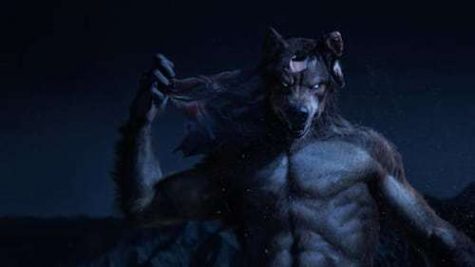 It perfectly sets up an interesting concept, but does not deliver. By the end, it boils down to some revenge story about werewolves and a generic moral that war is bad. Partnered with this, it has some of the least interesting characters, the ugliest animation style, and the cherry on top in that it is one the longer side of run times, rounding out at about 16 minutes. This episode, more or less, exemplifies every issue Love, Death & Robot has. Certain episodes have the tendency to drag on, even those with shorter run times. Along with this, quite a few episodes suffer from trying to be profound or “woke” but just come off as pretentious. Another glaring issues is in the accessibility of the shows in terms of actual content. The show is rated TV-MA, which they makes known quite liberally. It features A LOT of graphic violence, or graphic nudity, or a mix of both in all of its episodes. Sometimes, it can work, as is the case with the episode “Good Hunting;” however, in many of the other episodes, it feels forced, almost as if they needed a nudity/violence quota per episode. It sounds stupid, but it seriously feels as if they had one. Some episodes tend to show excessive gore or nudity for basically no reason. This ultimately has the capability of ruining or diminishing the effects the show may have on the viewer.
It perfectly sets up an interesting concept, but does not deliver. By the end, it boils down to some revenge story about werewolves and a generic moral that war is bad. Partnered with this, it has some of the least interesting characters, the ugliest animation style, and the cherry on top in that it is one the longer side of run times, rounding out at about 16 minutes. This episode, more or less, exemplifies every issue Love, Death & Robot has. Certain episodes have the tendency to drag on, even those with shorter run times. Along with this, quite a few episodes suffer from trying to be profound or “woke” but just come off as pretentious. Another glaring issues is in the accessibility of the shows in terms of actual content. The show is rated TV-MA, which they makes known quite liberally. It features A LOT of graphic violence, or graphic nudity, or a mix of both in all of its episodes. Sometimes, it can work, as is the case with the episode “Good Hunting;” however, in many of the other episodes, it feels forced, almost as if they needed a nudity/violence quota per episode. It sounds stupid, but it seriously feels as if they had one. Some episodes tend to show excessive gore or nudity for basically no reason. This ultimately has the capability of ruining or diminishing the effects the show may have on the viewer.
Best Episodes: “Good Hunting,” “When the Yogurt Took Over,” “Alternate Histories”, “The Witness”
Worst Episodes: “Shape-Shifters,” “Beyond the Aquila Rift,” “Sucker of Souls”
So, to restate my question from earlier “How does it hold up to other anthology series?” Well, it pales in comparison its predecessors such as The Twilight Zone, but it holds up pretty well to its modern contemporaries such as Black Mirror. The show, overall, is incredibly inconsistent. It has some tremendous moments scattered throughout its 18 episodes, but it has too many lack-luster episodes to be considered a great show. It’s truly a shame because many concepts could work perfectly if presented better. Overall, the show should be watched by anyone who has Netflix, and is looking for something that is easy to binge. Taking a lazy afternoon to watch the series definitely isn’t a bad idea. Hopefully, if the show continues for a second season, it becomes a more consistent anthology series.

Q: Which fictional character do you think would be the most boring to meet in real life?
A: Harry Potter because he seems like he would be pretentious...

Q: What are you most excited about for your last football season?
A: I know it’ll sound cliché but, personally, I’m looking forward to the homecoming...

Q: What type of music are you into?
A: I’m into rap and hip hop mainly, but I like R&B too.
Q: What made you want to play football or sports...


